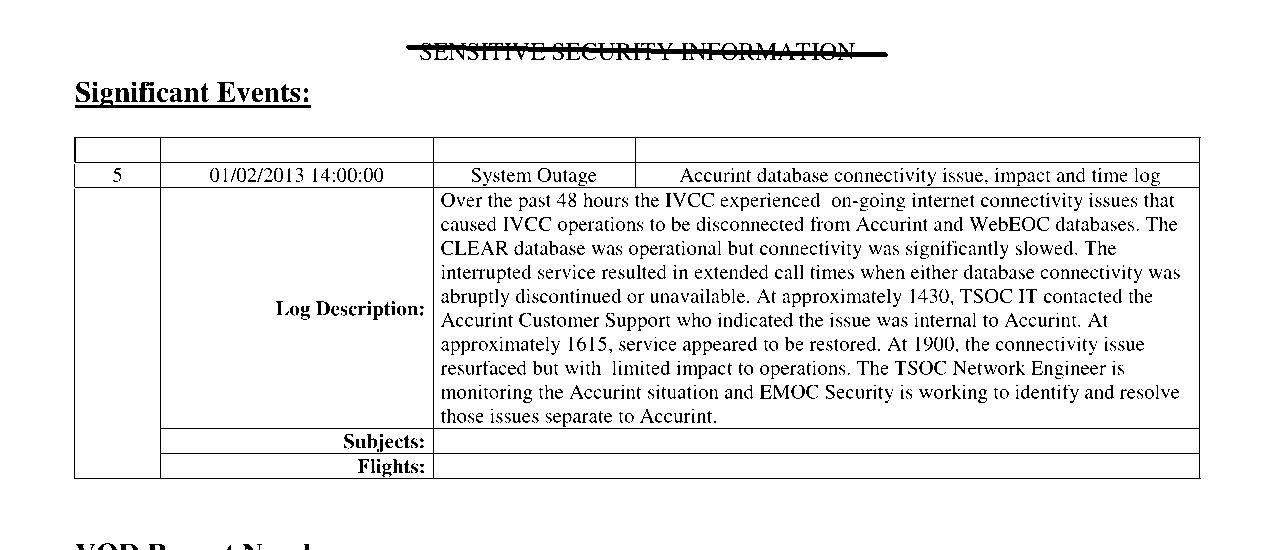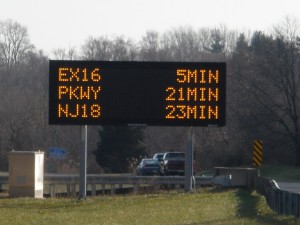Accurint exposed as data broker behind TSA “ID verification”
The most recent documents released in response to one of our Freedom of Information Act (FOIA) requests may have identified the data broker powering the TSA’s “ID verification” system as Accurint — the current incarnation of a component of the discredited and supposedly disbanded Total Information Awareness program — rather than Acxiom as we had speculated (and as had powered other TSA passenger-profiling schemes).
We found this clue to the company behind the curtain in the daily reports on the operation of the TSA Identity Verification Call Center (IVCC) that gets the call whenever someone tries to fly without having, or without being willing to show, government-issued ID satisfactory to the TSA or contractor staff at an airport checkpoint:
Over the past 48 hours the IVCC experienced on-going internet connectivity issues that caused IVCC operations to be disconnected from Accurint and WebEOC databases…. The interrupted service resulted in extended call times when either database conductivity was abruptly discontinued or unavailable. At approximately 1430, TSOC IT contacted the Accurint Customer Support who indicated the issue was internal to Accurint. At approximately 1615, service appeared to be restored. At 1900, the connectivity issue resurfaced but with limited impact to operations. The TSOC Network Engineer is monitoring the Accurint situation and EMOC Security is working to identify and resolve those issues separate to Accurint.
This report strongly suggests that it’s Accurint that provides the database and “verification” algorithms used by the IVCC, the TSA, and TSA contractors to decide who to allow to fly, and who not to allow to fly. There’s no other apparent reason why the IVCC would need connectivity to Accurint, or why an outage in IVCC connectivity would would be significant.
Who are these guys? It’s a shell game of acronyms, acquisitions, and corporate restructuring.
Accurint is a service of the LexisNexis brand of the UK-incorporated RELX Group plc, which until June 2015 was named Reed Elsevier. The aggregated “garbage in, garbage out” database and pre-crime profiling algorithms used by Accurint for “ID verification” were developed by a company called Seisint, under contracts (brokered in part by Rudy Giuliani’s influence-peddling consultancy) to the DHS and Department of Justice, for the MATRIX (Multistate Anti-Terrorism Information Exchange) component of Total Information Awareness (TIA).
In the midst of public controversy over MATRIX, TIA, and other aspects of Seisint and its operations, Seisint was acquired by Reed Elsevier for $775 million in 2004. Seisint’s Accurint service was folded into LexisNexis, part of what is now RELX Group plc.
“Matrix reloaded”?
Here’s what Megan Kaushik of the Brennan Center for Justice found when she tried to find out what’s in Accurint’s files about herself:
After an exhaustive search, I ultimately received records from … LexisNexis’s Accurint…. The report[] listed every phone number and address I had ever been associated with, from my college mailbox to the relative’s home where I’d forwarded mail while abroad. Accurint listed the apartment I rented while interning in DC, along with the names and phone numbers of its current occupants. It even provided the sale price and mortgage on each home I’d lived in.
Surprisingly, much of the information was also inaccurate….
Accurint listed someone named Florinda as “Associated with Subject’s SSN” though it assured me this “doesn’t usually indicate fraud.”
Obtaining my data … was difficult. Amending incorrect information was impossible. Unlike Canada or the UK where data brokers must allow individuals to access and amend their data, American law lacks such requirements. Accurint’s report stated it “may not contain all personally identifiable information in our databases” and they “do not verify data, nor is it possible to change incorrect data.”
In addition, “LexisNexis does not suppress personal information from databases used by law enforcement customers,” regardless of whether LexisNexis knows it to be inaccurate or misleading. As we said earlier, “garbage in, garbage out”. All the garbage, no matter how much it stinks.
Since its latest latest corporate restructuring in June 2015, Accurint has been operated by a UK corporation, RLEX Group plc. Stock in RLEX Group plc is owned partly by a UK-based and partly by a Netherlands-based parent corporation. But there’s no US-incorporated subsidiary to shield RLEX Group plc, as a UK corporation, from its obligation to comply with UK law in its worldwide operations, whether in the US or anywhere else.
Many of Accurint’s policies and practices with respect to its services for the TSA and other law enforcement agencies appear to violate both the LexisNexis privacy policy and, more importantly, the obligations of RLEX Group plc pursuant to UK and European Union data protection law. The governing factor under UK and EU law appears to be that the data controller for Accurint, RLEX Group plc, is legally domiciled in the UK.
It doesn’t help rescue RELX Group plc from liability under UK and EU law that it has relied on self-certification that it complies with the “safe harbor” framework, which has now been ruled legally inadequate, as the basis for transferring personal data to entities in the US such as the TSA.
Accurint also integrates social media data from “Twitter, Tumblr, Disqus, Foursquare, WordPress, Instagram, Facebook, Google+, YouTube and more,” monitored and mined by Digital Stakeout, Inc. This confirms what we have long feared: that (privatized but government-funded) surveillance of social media and other Internet activity is being used as one of the inputs to the black box that decides whether to allow us to exercise our rights. As we said five years ago in conjunction with the first “Social Network Users’ Bill of Rights”:
In such a world, your “identity” is what these companies say it is. Where do these private companies think you lived, and with whom, in a certain year, for example? An identity thief who has gotten your files may be more likely than you are to to know the “correct” answer. And each time such a commercial service is used to verify your ID for government purposes, the service provider has a record of the transaction to add to its dossier about you, and use for whatever purposes it chooses.
We’ll be posting more details and statistics as the TSA releases more of its records about what happens to people who try to fly without ID. But the records we’ve received to date show that people are already being prevented from traveling by air, despite having valid tickets on common carrier airlines, because the private data broker(s) consulted by the TSA don’t have enough data to profile them, or their answers don’t correspond to the garbage in the aggregators’ data warehouses about things such as who Accurint thinks they live with or thinks who their neighbors are.

